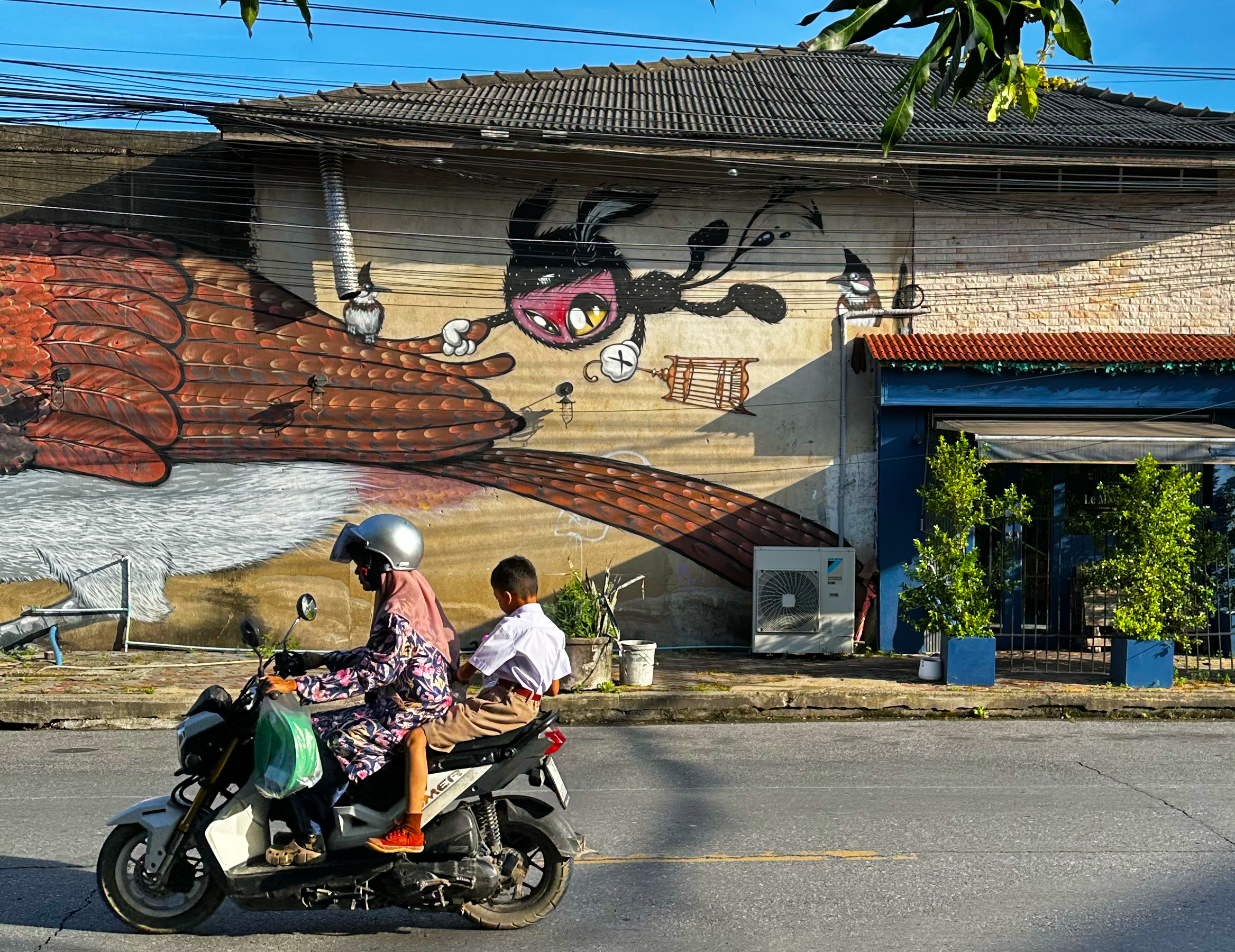The Deep South had always been a corridor for me – a stretch of road between Malaysia and Hat Yai, its provinces (Narathiwat, Pattani, Yala) mere waypoints. I’d crossed at Sungai Kolok countless times, avoiding the busier Sadao route, but never stayed long enough to look beyond the checkpoints and gas stations. On this trip, with time pressing but curiosity undimmed, I chose stillness over motion: to sleep where I’d once only shifted gears, and to hear the stories woven into the rhythm of these misunderstood places.
The route to Sungai Kolok traced Malaysia’s East Coast – a mix of quiet trunk roads and the short, solitary E8 expressway between Kuantan and Terengganu, offering only a brief reprieve from the winding coastal stretch. A straight-through ride would have been exhausting, and worse, hollow; some of the best stories are found when you step off the saddle. So I broke the journey with a stop in Sungei Lembing [林明山] – nicknamed El Dorado of the East – where the skeletal remains of tin mines stood as quiet sentinels to a fading industrial past – a fitting prelude to the layered history waiting across the border.
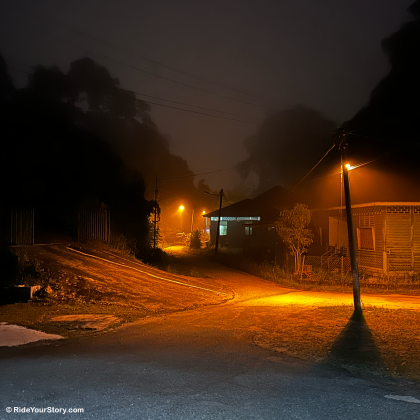
Where the Mines Fell Silent
I last visited Sungei Lembing before Covid pandemic – that hated disruption to all travelers. When the town still clung to its tin-mining past, its century-old wooden shophouses standing as weary witnesses to history. Then, in 2019, a fire gutted much of the old quarter, erasing chunks of its heritage in smoke. But something deeper felt fragile: the aging community, dwindling and unsupported, seemed to mirror the town’s slow fade. Progress hasn’t abandoned it; people have. Without new life – young blood, fresh purpose – this place risks becoming a relic, preserved only in memory. With the right infrastructure, this town could thrive as a haven for digital nomads – but progress demands its price. The choice between preservation and reinvention now rests with the next generation, who must weigh legacy against change.
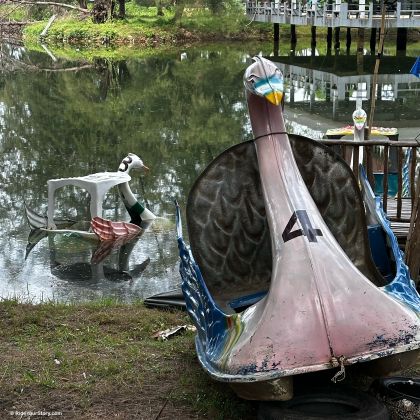
Threshold of Whispers
From Sungei Lembing’s quiet streets, the E8 expressway beckoned as the nearest artery north – a rider’s dream of wide, empty lanes unfurling toward the border, its effortless flow a stark contrast to the congested North-South Expressway’s choked veins. But the luxury ended at Terengganu, where the road narrowed back into the familiar rhythm of trunk routes. Along the way, skeletal pylons of the under-construction East Coast Rail Link traced the future’s outline.
Reaching Rantau Panjang, I filled my tank to the brim at the last petrol station – border economics 101 – before rolling up to Kompleks ICQS Rantau Panjang. Exiting Malaysia was effortless, as routine as a cross-border dash to Singapore. Then came Su-ngai Golok Checkpoint’s streamlined efficiency (the Thai spelling of Sungai Kolok, still the same river boundary). A single complex housing three counters required – passport control, temporary vehicle import permit, and Thai insurance – each step brisk, no back-and-forth. A rare triumph of bureaucracy, letting me focus on the road ahead rather than paperwork – though savvy travelers should note some submissions can done digitally before arrival.
I skipped staying in Sungai Kolok again this time – like the other border towns, it thrums with a predictable chaos: tight crowds, and the faint whiff of transactions best left to daylight – some legal, some less so, all orbiting the oldest trade thriving in these in-between places. That story could wait for another entry. Instead, I twisted the throttle northward, letting the 70km stretch to Narathiwat’s quieter core smooth out the crossing’s grit. The road here has its own rhythm: military checkpoints dissolving into village markets, and the creeping realisation that ‘Troubled South’ is a label, not a place.
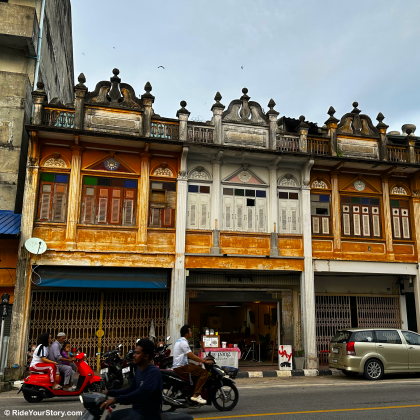
Where the Streets Hold Their Breath
This was my second time staying in Narathiwat’s main town, and the air felt lighter than before – though not weightless. Concrete blast barriers still hugged shopfronts like stubborn scars, a mute reminder of what this province has weathered. The night market stretched its awnings over near-empty aisles; vendors shuttered early, the city folded into itself. But between the quiet, new threads of life: espresso machines hissed in minimalist cafés, and fast-food counters run by sharp-eyed youth offered neon-lit menus. Progress, perhaps – or just new generation refusing to surrender to the script. Still, the absence spoke loudest: no foreign backpacks, no hostel chatter, just Malaysian day-trippers browsing the market, local families on pit stops, and the occasional rider (like me) using the town as a waypoint. Even hope here moves cautiously.
Locals speak Southern Thai here, though basic Malay or Central Thai works in a pinch – enough to share a laugh or ask directions. Despite the headlines (a bombing had shaken the province just two days before my arrival), I was met only with warm curiosity from Thai-Malay locals. Foreign travelers are rare enough that my presence drew smiles, though laced with questions: What brings you here? Tomorrow’s short ride would grant me time to dig deeper, but today revealed the quiet rhythm of lives anchored to inherited land, where leaving isn’t an option, even as insurgency shadows progress.
The landscape itself spoke of coexistence: a Buddhist temple’s golden chedi stood shoulder-to-shoulder with a masjid’s minaret, while a crumbling Chinese shrine – relic of Hainanese migrants – whispered of older layers now fading. It was harmony under strain. The uncompromising ambitions of a few, clinging to visions of bygone sovereignty, cast a shadow over the many who simply sought stability – their ideological struggle quietly smothering the aspirations of an entire generation. The insurgent presence, though sporadic, felt like a lid clamped over the ambitions of the young baristas, the market vendors, the mothers shepherding kids past checkpoints. Normalcy persisted, but in whispers.
Just days before my arrival, multiple explosions, believed by authorities to be aimed at creating regional unrest, struck the Red Cross Fair in Muang District, Pattani Province, leaving seven injured.
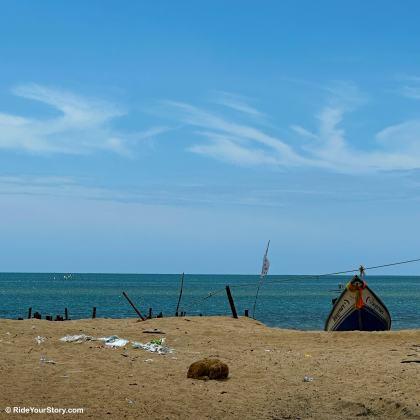
Before the Tide Takes More
I skipped staying in Pattani this time, though its streets still hummed with more life than Narathiwat’s quiet lanes. Instead, I detoured through a coastal village, where fishermen paused their work to study me – a stranger on two wheels – as I lost myself in the South China Sea’s endless horizon. Time blurred there. Later, I bypassed Pattani city entirely, partly wary of recent unrest, but mostly because the backroads called: a quieter, lonelier path winding toward Yala, far from the usual fray. Still, I marked this in my mind for return. My geotagged photos from a past trip now tell a different story – Google Maps shows stretches of road that once carried my tires now submerged, claimed by the sea. Next trip, I’ll revisit those drowned paths, tracing the slow surrender of land to water.
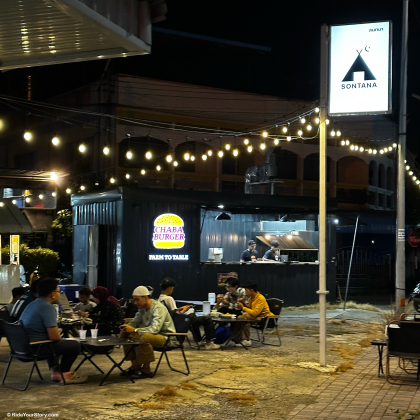
Slower Speed, Richer Finds
Yala – my first time staying in the provincial capital – greeted me with scorching afternoon heat as I checked in, immediately ordering food delivery to escape the sun. The blazing weather, at least, was perfect for washing and drying my gear. By evening, the city surprised me: its streets pulsed with more life than Narathiwat’s, and I stumbled upon a hip enclave where young locals clustered over iced coffees and western indulgences, their laughter cutting through the humid air. Here, I decided, was where I’d linger—letting the evening’s energy soak into my road-weary bones.
Yala wears its scars quietly. In September 1977, King Bhumibol Adulyadej and Queen Sirikit narrowly escaped assassination here when a bomb planted by the BRN insurgents detonated near their motorcade—a grim reminder of the Deep South’s simmering tensions.
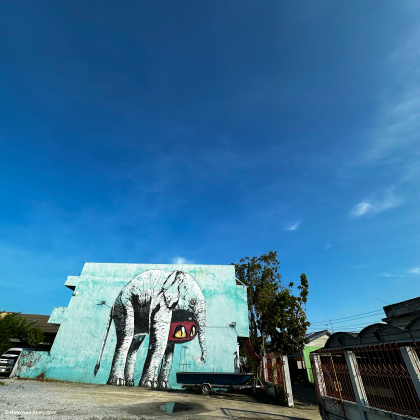
The next morning, I set off on foot to finally find the Bird City Street Art – vibrant murals I’d missed on past rides. Created by Silpakorn University students under Archarn Amarith Choosuwan’s guidance, the murals turned alleyways into galleries, proving how much slips by at saddle-speed. Yala’s charm – part bustling, part artistic -sealed its fate: my new alternate stopover when skipping tourist-heavy Hat Yai. Though Pattani whispers rival promises – too many roads, too little time.
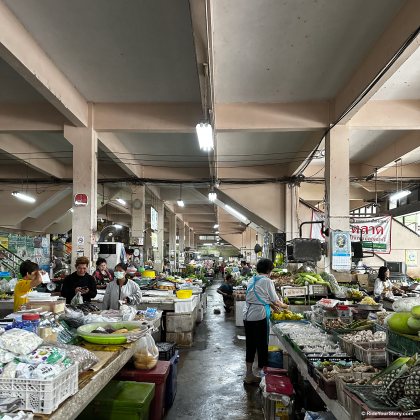
The Border Town That Waits
Next stop: Betong, Yala province’s border gem, via the infamous Route 410 – a serpentine tarmac ribbon and the Mae Hong Son loop’s spirit, minus the endurance test. This highway stitches together rubber plantations and misty highlands, but today, I’m riding straight to my hotel, bypassing attractions like the caves, tunnels and hot springs.
Geographically – and unfortunately, as an overlander – Singapore dangles like a pendant off Eurasia’s chin. Our only overland escape is north, funneling us irrevocably through these borderlands. Betong, then, is less a choice than a recurring waypoint – just like Padang Besar, Sadao, and every other frontier town we’ll inevitably roll through again. The rhythm of border-hopping is written into our maps.
The town itself feels like a Malaysian sibling frozen in time: weathered shophouses built by Hokkien and Hakka settlers generations ago, kopitiam chatter in thickly-accented Thai-Chinese dialects, and motorbike exhaust, with Thai signage the sole reminder you haven’t slipped into a parallel universe. Little had changed since my last visit – border towns like this, thriving on cross-frontier trade, wear their resilience openly. Dinner options were familiar, neither spectacular nor scarce. But when the road is your true destination, predictability is its own comfort.
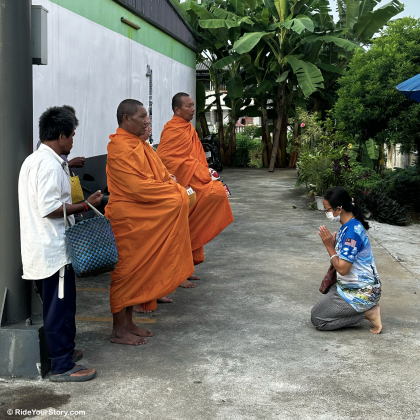
The Reluctant Return: Palm Tree Monotony
The journey home began with reluctance – no marathon ride straight through, but a deliberate pause in Ipoh. My preferred route down Malaysia’s East Coast wasn’t an option this time; the mountains severed any direct path from the northwest, forcing me back onto the predictable west. Ipoh greeted me with its usual culinary fanfare (a world apart from Singapore’s fading heritage food traditions), but the city’s hustling energy felt abrasive in my solo-travel weariness. I paid my obligatory respects with a plate of Nga Choy Kai – Ipoh’s iconic bean sprout chicken rice – more ritual than craving.
By dawn the next morning, I was rolling south on the North-South Expressway, its monotony of palm plantations and cleared future-palm-land blurring into a green-brown lullaby. Home beckoned, but the road, as always, demanded one last act of focus: eyes forward, throttle steady, the familiar surrender to asphalt.
